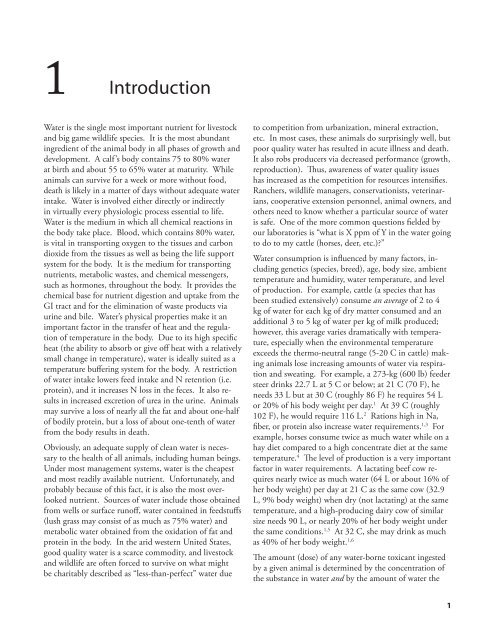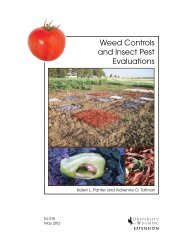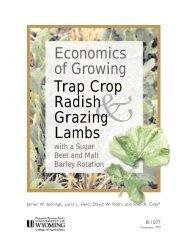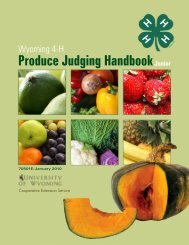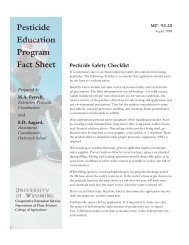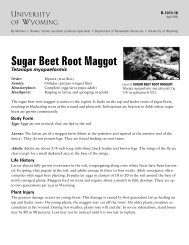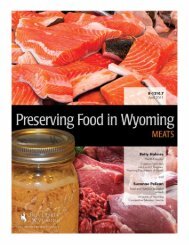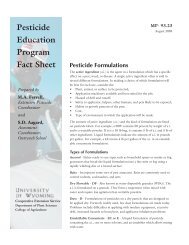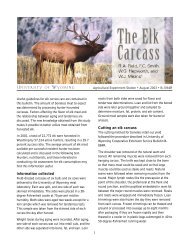Water Quality for Wyoming Livestock & Wildlife - Coming Soon!
Water Quality for Wyoming Livestock & Wildlife - Coming Soon!
Water Quality for Wyoming Livestock & Wildlife - Coming Soon!
You also want an ePaper? Increase the reach of your titles
YUMPU automatically turns print PDFs into web optimized ePapers that Google loves.
1 Introduction<strong>Water</strong> is the single most important nutrient <strong>for</strong> livestockand big game wildlife species. It is the most abundantingredient of the animal body in all phases of growth anddevelopment. A calf’s body contains 75 to 80% waterat birth and about 55 to 65% water at maturity. Whileanimals can survive <strong>for</strong> a week or more without food,death is likely in a matter of days without adequate waterintake. <strong>Water</strong> is involved either directly or indirectlyin virtually every physiologic process essential to life.<strong>Water</strong> is the medium in which all chemical reactions inthe body take place. Blood, which contains 80% water,is vital in transporting oxygen to the tissues and carbondioxide from the tissues as well as being the life supportsystem <strong>for</strong> the body. It is the medium <strong>for</strong> transportingnutrients, metabolic wastes, and chemical messengers,such as hormones, throughout the body. It provides thechemical base <strong>for</strong> nutrient digestion and uptake from theGI tract and <strong>for</strong> the elimination of waste products viaurine and bile. <strong>Water</strong>’s physical properties make it animportant factor in the transfer of heat and the regulationof temperature in the body. Due to its high specificheat (the ability to absorb or give off heat with a relativelysmall change in temperature), water is ideally suited as atemperature buffering system <strong>for</strong> the body. A restrictionof water intake lowers feed intake and N retention (i.e.protein), and it increases N loss in the feces. It also resultsin increased excretion of urea in the urine. Animalsmay survive a loss of nearly all the fat and about one-halfof bodily protein, but a loss of about one-tenth of waterfrom the body results in death.Obviously, an adequate supply of clean water is necessaryto the health of all animals, including human beings.Under most management systems, water is the cheapestand most readily available nutrient. Un<strong>for</strong>tunately, andprobably because of this fact, it is also the most overlookednutrient. Sources of water include those obtainedfrom wells or surface runoff, water contained in feedstuffs(lush grass may consist of as much as 75% water) andmetabolic water obtained from the oxidation of fat andprotein in the body. In the arid western United States,good quality water is a scarce commodity, and livestockand wildlife are often <strong>for</strong>ced to survive on what mightbe charitably described as “less-than-perfect” water dueto competition from urbanization, mineral extraction,etc. In most cases, these animals do surprisingly well, butpoor quality water has resulted in acute illness and death.It also robs producers via decreased per<strong>for</strong>mance (growth,reproduction). Thus, awareness of water quality issueshas increased as the competition <strong>for</strong> resources intensifies.Ranchers, wildlife managers, conservationists, veterinarians,cooperative extension personnel, animal owners, andothers need to know whether a particular source of wateris safe. One of the more common questions fielded byour laboratories is “what is X ppm of Y in the water goingto do to my cattle (horses, deer, etc.)?”<strong>Water</strong> consumption is influenced by many factors, includinggenetics (species, breed), age, body size, ambienttemperature and humidity, water temperature, and levelof production. For example, cattle (a species that hasbeen studied extensively) consume an average of 2 to 4kg of water <strong>for</strong> each kg of dry matter consumed and anadditional 3 to 5 kg of water per kg of milk produced;however, this average varies dramatically with temperature,especially when the environmental temperatureexceeds the thermo-neutral range (5-20 C in cattle) makinganimals lose increasing amounts of water via respirationand sweating. For example, a 273-kg (600 lb) feedersteer drinks 22.7 L at 5 C or below; at 21 C (70 F), heneeds 33 L but at 30 C (roughly 86 F) he requires 54 Lor 20% of his body weight per day. 1 At 39 C (roughly102 F), he would require 116 L. 2 Rations high in Na,fiber, or protein also increase water requirements. 1,3 Forexample, horses consume twice as much water while on ahay diet compared to a high concentrate diet at the sametemperature. 4 The level of production is a very importantfactor in water requirements. A lactating beef cow requiresnearly twice as much water (64 L or about 16% ofher body weight) per day at 21 C as the same cow (32.9L, 9% body weight) when dry (not lactating) at the sametemperature, and a high-producing dairy cow of similarsize needs 90 L, or nearly 20% of her body weight underthe same conditions. 1,5 At 32 C, she may drink as muchas 40% of her body weight. 1,6The amount (dose) of any water-borne toxicant ingestedby a given animal is determined by the concentration ofthe substance in water and by the amount of water the1


